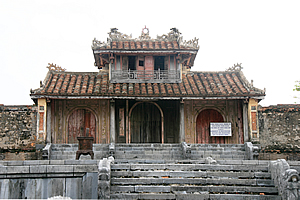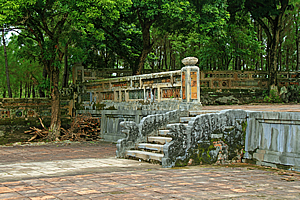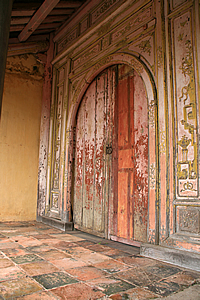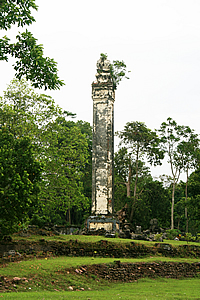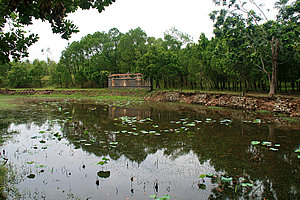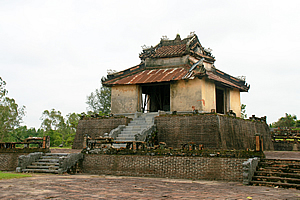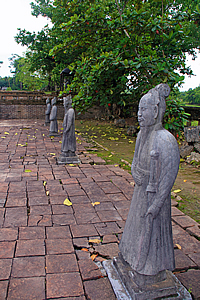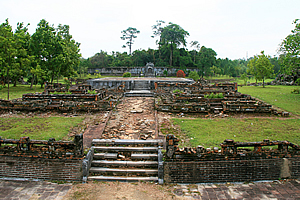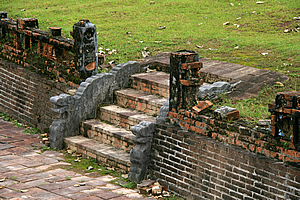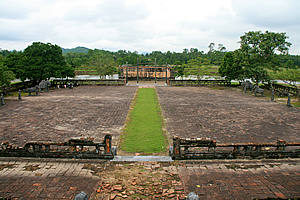--- Archive files ---
Home > Travels > Hue > 8 |
The Emperor’s Remains Has Never Been Found
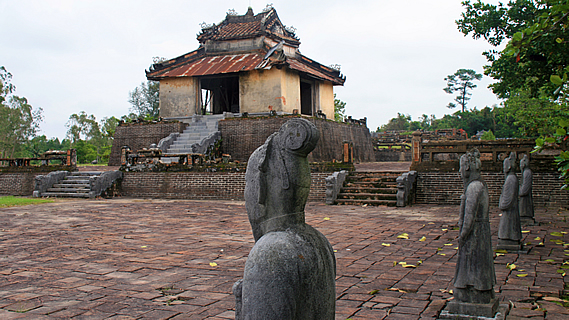
THROUGHOUT history, almost every royal person has lived larger than life with their flamboyant opulence. The affluence seems to only increase upon their death where they leave a final statement to set their legacy in stone.
The mausoleum |
Five minutes had passed since leaving the top of the hill overlooking the Perfume River ridden on the back of motorbikes. We arrived at what appeared to be a dilapidated temple, worn and eroded with age. This was the mausoleum where the body of Tu Duc, one of the Nguyen emperors’, had been prepared for burial at the height of the dynasty sometime in the 1860s.
The building sat in a large brick courtyard on a gentle hill slope surrounded by a low pond with lilies growing in it. I’m not sure if this was supposed to be a permanent pond, but it had probably once been a moat that had gradually filled with silt over the centuries. During the rainy season it would still be filled with water, but no doubt it would dry up during the dry season. The grassy land surrounding the pond was very swampy, but fortunately the gravel road was built up well above the water providing a firm surface to walk on.
Entrance to the mausoleum |
A four pillar open gateway led into the courtyard from the road. We climbed the worn marble stairs up a couple of levels of large courtyard on the approach to the mausoleum building. The railings of the stairs were once elaborately carved marble dragons, but they were now severely eroded with moss growing on their lower edges. The mausoleum building itself was locked up for renovations with the three arched entrances having solid timber doors locked to preventing access. We stayed in the courtyard for a while before climbing down it and following the road walking towards the burial site.
Gate of the mausoleum |
Stone pillar |
On the way to the tomb, we walked past the pond, going past the deep end where stone walls holding it in place. It was little more than a stagnant pond with smatterings of lilies growing on the surface. Given the recent flood rains of the typhoon, this must be pretty dry over much of the year.
Lake outside the mausoleum |
We walked along some small fields and saw a twelve metre high pillar standing majestically at the edge of a low forest. The base of the square pillar was one by one metre. The buff yellow plain stone on the surface was severely dirtied by the moss and fungus growing on it. We crossed a low bridge over a straight canal of grey water held by stone retaining walls on either side. Once across the bridge, my tour leader Danh showed us a small leafy plant growing in the grass. It didn’t appear to be anything special until he touched the leaves. Then it suddenly folded on itself. I have never seen so much energy in any plant apart from the Venus flytrap. The speed at which these leaves folded came pretty close, though it wouldn’t be enough to capture small animals.
Temple above the tomb |
Then we reached the entrance to the huge tomb.
It’s interesting that kings of many nations consider themselves to be immortal. They all know they are going to die, but they often create elaborate tombs to prepare them for some kind of resurrection. Of course most religious people believe in some form of afterlife, whether it is through resurrection, reincarnation, or by passing into a new life. The kings were very wealthy, so they were able to express this passing through very elaborate tombs.
Marble statues |
This was no exception. Although this didn’t even come close to ranking to the pyramids of Giza in Egypt, this tomb area covered several acres. We passed a courtyard containing a row of life sized marble carvings of priests on either side petrified for eternity. At one end of each row of priests stood a marble horse and a marble elephant, both out of proportion with exaggerated torsos and small heads and legs. They were all geometric and positioned very deliberately like the pieces on a chess board. Any Buddhist priest would understand the meaning of these statues, and why they were located where they were, but to us mere foreigners, this was just a collection of very interesting statues, on a giant chess board eroded with years of decay.
The slate stones on the courtyard were worn and uneven, as if shaken up by a huge earthquake. It had been well weeded though. A group of small trees surrounded the chess board courtyard, with protruding marble formations around the trunks. Perhaps these trees were once part of a hedge.
Ruins of the emperor's tomb |
A three metre wide strip of mowed lawn went up the middle of the paving, pointing towards a solitary building on a low artificial hill of eroded bricks. Two short flights of stairs went up into the yellow building with a terracotta roof. The walls had large open entrances on all sides. The building itself was even more derelict than the courtyard.
We climbed the stairs into the solitary building, passing two tiny pagodas with griffins on either side with their heads turned facing us. Although the building was starting to crumble, it was still safe enough for us to enter. The walls were open providing us with views of the courtyard we had come from, and of the large burial area, covering several hectares. Inside the building was a large stone plaque with characters no doubt providing information about the king who was buried somewhere in this huge tomb.
Steps into the tomb |
We walked outside the other side of the building to see the actual burial ground, huge and yet severely eroded with the bricks from the walls separating the different sections crumbling into piles of rubble. The burial area was symmetrical, with a couple of small stone buildings and more twelve metre pillars. Again there would be meaning ascribed to every temple and building in this complex. It was all severely crumbling from the vegetation growing over it, converting the stone into soil. The central building was the obvious resting place for the king, but Danh mentioned the body had deliberately been buried in a secret place here. They have tried x-ray scans around different areas, but to date they have not found the location of the king’s remains. I wondered if he was even buried here at all. Nobody knows. All two hundred servants who were involved in the king’s burial were promptly beheaded to conceal the secret forever.
Courtyard in front of the tomb |
There’s something really nostalgic about a ruin showing the neglect of weather erosion and vegetation growing over it. This reminded me of a school near where I lived when growing up. It had been closed when a new school was opened. I went to the new school, but the old one was simply abandoned. The Ministry of Education mustn’t have had the funds to arrange for its demolition. The old school just sat there decaying from neglect slowly taken over by the growing weeds.
I recalled reading that if humans were to suddenly vanish from the face of the Earth everything that we had ever built would very quickly decompose. Even stone structures would quickly erode away with the erosion of weather and the decay of plants. Within fifty thousand years, all evidence of human civilisation would be lost forever. This ruin was definitely showing how this happens. I’m sure people have been assigned to work in here, but no matter how much renovation and maintenance is done here; the inevitable decay of time will eventually win.
<< Previous | Next >> |
|
||
About this Page
|
||
|
|
|
Where is Walkabout Jeff? |
|
|
|
|
What is happening in Walkabout Jeff's hometown?
|
|
|
|
|
Who is Walkabout Jeff?Any normal person's idea of going out involves going to the local pub for a drink with a few mates. Walkabout Jeff isn't normal.
|
|
|
|
|
